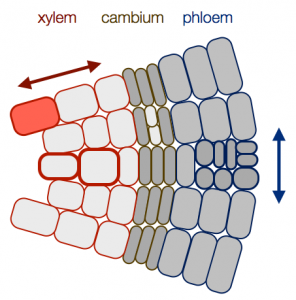 It is an often neglected, but one of the most important growth processes in plants: secondary growth, the thickening of stem and root structures by radial expansion. We used the Arabidopsis hypocotyl as a model for this process, because its later phase secondary growth is reminiscent of trees and can be triggered at will via a transgenic system. The process is massive in scale, even the small Arabidopsis hypocotyl grows from a few hundred to several thousand cell files in only a few weeks. Nevertheless, it is strictly patterned. Find out about our work on secondary growth in the following publications:
It is an often neglected, but one of the most important growth processes in plants: secondary growth, the thickening of stem and root structures by radial expansion. We used the Arabidopsis hypocotyl as a model for this process, because its later phase secondary growth is reminiscent of trees and can be triggered at will via a transgenic system. The process is massive in scale, even the small Arabidopsis hypocotyl grows from a few hundred to several thousand cell files in only a few weeks. Nevertheless, it is strictly patterned. Find out about our work on secondary growth in the following publications:
Fabio Lehmann and Christian S. Hardtke (2016): Secondary growth of the Arabidopsis hypocotyl — vascular development in 4 dimensions. Current Opinion in Plant Biology, Vol. 29: pp. 9-15.
Martial Sankar, Kaisa Nieminen, Laura Ragni, Ioannis Xenarios and Christian S. Hardtke (2014): Automated quantitative histology reveals vascular morphodynamics during Arabidopsis hypocotyl secondary growth. eLife, https://dx.doi.org/10.7554/eLife.01567.
Laura Ragni and Christian S. Hardtke (2013): Small but thick enough – the Arabidopsis hypocotyl as a model to study secondary growth. Physiologia Plantarum, doi: 10.1111/ppl.12118.
Laura Ragni, Kaisa Nieminen, David Pacheco-Villalobos, Richard Sibout, Claus Schwechheimer and Christian S. Hardtke (2011): A direct stimulatory role of mobile gibberellin in Arabidopsis hypocotyl xylem expansion. The Plant Cell, Vol. 23: pp. 1322-1336.
Richard Sibout, Stephanie Plantegenet and Christian S. Hardtke (2008): Flowering as a condition for xylem expansion in Arabidopsis hypocotyl & root. Current Biology, Vol. 18: pp. 458-463.
 It is an often neglected, but one of the most important growth processes in plants: secondary growth, the thickening of stem and root structures by radial expansion. We used the Arabidopsis hypocotyl as a model for this process, because its later phase secondary growth is reminiscent of trees and can be triggered at will via a transgenic system. The process is massive in scale, even the small Arabidopsis hypocotyl grows from a few hundred to several thousand cell files in only a few weeks. Nevertheless, it is strictly patterned. Find out about our work on secondary growth in the following publications:
It is an often neglected, but one of the most important growth processes in plants: secondary growth, the thickening of stem and root structures by radial expansion. We used the Arabidopsis hypocotyl as a model for this process, because its later phase secondary growth is reminiscent of trees and can be triggered at will via a transgenic system. The process is massive in scale, even the small Arabidopsis hypocotyl grows from a few hundred to several thousand cell files in only a few weeks. Nevertheless, it is strictly patterned. Find out about our work on secondary growth in the following publications: